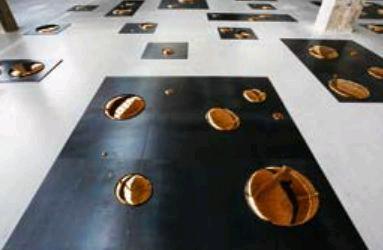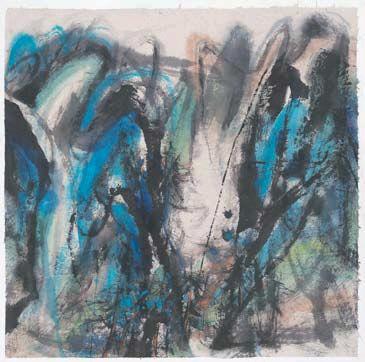Material Essence
Born in 1977 in Harbin in northeastern China, Hu Xiaoyuan graduated from the Central Academy of Fine Arts in 2002 and currently lives and works in Beijing. Hu explores the essence of objects and daily life experience through an artistic language focused on natural materials such as hair, old textiles, discarded wood and raw silk. Hus minimal yet highly poetic style unearths expression in a wide range of forms, including installation, painting and video. Since 2008, she has worked primarily with wood, through a perspective of observation and study, in pursuit of creative energy, starkly contrasting her earlier work, while also redefining the relationship between object and form. Hus wood series, Wood Rift and Wood No. 7, attempts to explore the limits of the objects themselves and their limitless nature as standardized forms. These two works offer new definitions of two-dimensional painting, three-dimensional sculpture and the latent qualities of materials. In Bugs Handwriting and Bugs Traces, Hu attempts to break the confines of traditional ink painting to depict a contemporary Chinese-style abstract landscape using seemingly random marks left by insects after being dipped in ink. The black walnut display case in Bugs Handwriting conveys poetic interaction between the artist and garden insects. Bugs Traces, meanwhile, employs an installation of video and wood to document the creative process behind the abstract ink painting.
Taipei Biennial – The Great Acceleration
Taipei Fine Arts Museum, Taipei
September 13, 2014 – January 4, 2015
Expressive Ink
Born in Beijing in 1965, Zhang Zhaohui, graduated from the Department of Museum Studies of Nankai University in 1988. He has worked for the National Art Museum of China and studied international contemporary art theory and exhibiting in New York. He pinpoints clear targets for his creations, yet at the same time maintains creative vitality. His paintings focus on both traditional Chinese ink painting techniques and individuality promoted by Western contemporary art. The artist excels at using simple styles to express the contrast between light and shadows, symbolizing unlimited space. He utilizes characteristics of traditional Chinese painting but makes them more expressive. The composition of white in his ink and paper work sets off a deep and tranquil concept glimmering with spiritual glory.
The Threads That Connect Us – Zhang Zhaohuis Ink Painting
September 13 - October 12, 2014
Red Gate Gallery, Beijing
Pop Porcelain
Born in Jiangxi Province in 1962, Liu Jianhua graduated from the Fine Arts Department of the Jingdezhen Ceramics Institute in 1989. Since 2004, Liu has been a professor at the Sculpture Department of the Fine Arts School of Shanghai University, where he currently lives and works. Liu is one of Chinas best known sculptors and installation artists, and he primarily utilizes porcelain and mixed media. Growing up in Jiangxi, he spent 14 years learning ceramic and porcelain craftsmanship at factories in Jingdezhen. After graduation in 1989, he started experimenting within a contemporary context. Lius porcelain and mixed media work reflects economic and social changes in China as well as problems that have followed. Since 2008, Liu Jianhuas focus has been exploring creative ways of depiction to contrast direct and realistic scenes. In order to fully reflect the purity of his work, the artist adopted the ancient craft of porcelain, which is accompanied by profound comprehension of the contemporary world. His work becomes concise without hardly any space for imagination. His various materials flow antagonistically and create power-shifts amidst a seemingly orderly arrangement, and the shared technology used to create the materials leaves viewers with a sublime feeling of interdependence. The artists intervention and spatial awareness, and freely spilled details, far
transcend the necessary threshold for deeper contemplation.
Liu Jianhua: Square
September 20 – November 8, 2014 Pace Gallery, Beijing
Portrait of Jin
Born in Jiaozuo, Henan Province, in 1934, Jin Shangyi graduated from the Painting Department of the Central Academy of Fine Arts in 1953. Now one of the most renowned oil painters in China, Jin once served as the president of the Central Academy of Fine Arts. With focus on portraits, he has developed a unique understanding of the humanistic themes, which has greatly contributed to his impressive achievements in portraits and his master status in art circles. The style of his portraits embodies not only his artistic skill but also his spirituality and cultural absorption. Spanning over half a century, Jins career has continued expressing his feelings about the times and soaking up characteristics of the eras. Since the late 20th Century, when China began to undergo great changes, Jin has constantly deepened his “theme of human being,” mirroring not only his personal life experience but also the countrys development.

Painting the Chinese Dream – Exhibition Celebrating the 65th Anniversary of the Founding of the Peoples Republic of China
September 23 – October 7, 2014
National Art Museum of China, Beijing
Think of Ink
Xuan Yongsheng is a Canadian Chinese artist who has earned great achievements in various artistic schools, such as Chinese ink painting, illustration, ceramics and woodblock print. Since the 1980s, he has been painting with ink in order to explore the unique style of contemporary Chinese ink painting and its fusion with expressive and natural art language. Through the informal aesthetic of traditional ink painting, the artist blends Chinese and Western elements, introducing diversity, self-awareness, self-sufficiency, and developmental logic which sustain the transformation of the Chinese ink painting language. He paves an artistic road embodying spiritual strength and aesthetic freedom with professional skill and tenacity. His recent exhibition highlighted Chinese ink paintings remarkable characteristics, which not only destroy rigid painting modes through the power of abstract imagery, but also revives its grandeur and profundity. In addition, he combines the characteristics of inclusive landscape painting, calligraphy, and Western contemporary painting to create a new style.
The Madness, Elegance, and Thrill of Ink –The Spirit and Style of Xuan Yongshengs Ink Painting
September 18 – 26, 2014
Today Art Museum, Beijing
